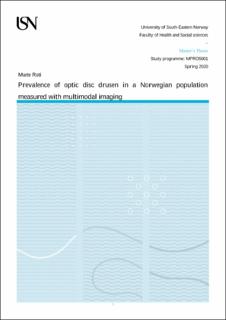| dc.description.abstract | Purpose
This study investigates the prevalence of optic nerve head drusen (ONHD) in a Norwegian population using different imaging methods; optical coherence tomography (OCT), autofluorescence (AF)-imaging and fundus photography – and further looks at some of the characteristics of the ONHD and its effect on the retinal nerve fiber layer (RNFL).
Methods
This is a cross sectional study where subjects above 18 visiting an optometric practice were recruited consecutively. The subjects who participated underwent an optometric examination that included SD-OCT, fundus photography and AF-images (Optomap). The images from both eyes were analysed and the presence, location and size of ONHD were registered. The size of ONHD was measured only in the OCT-images. Cohen’s kappa was used to analyse the interrater reliability between the imaging methods, and differences between groups were analysed with Welch’s ANOVA and independent T-test, and a p-value <0.05 was considered significant.
Results
305 subjects were included with a mean age of 45.41 (± SD 14.73) where 61.3% were women. ONHD was prevalent in 23 (7.5% [CI 4.8-11%]) of subjects identified with SD-OCT; 10 (3.3% [CI 1.6-5.9%]) of subjects identified with fundus photography; 22 (7.2% [CI 4.6-10.7%]) of subjects identified with AF-imaging. The mean age of subjects identified with ONHD measured with OCT was 41.8 years (SD ±12.87) where 69.9% were female. ONHD were bilateral in 60.9% of these cases.
AF-imaging compared to OCT had a sensitivity of 89.5% (Kappa=0.94) and 77.8% (Kappa=0.87) of right (RE) and left (LE) eyes respectively. Fundus photography compared to OCT had a sensitivity of 31.6% (Kappa=0.46) and 44.4% (Kappa=0.601) of RE and LE respectively.
When measuring the ONHD diameter with OCT, those who were not visible on AF-images (non-hyperautofluorescent) had a significantly smaller diameter compared to the diameter of the hyperautofluorescent ONHD (p<0.023 RE and p<0.001 LE). The clinically visible ONHD had a larger diameter than the buried ONHD (p<0.05 for both eyes). ONHD were least present in the temporal quadrant of the ONH for all imaging methods. The global RNFL thickness were thinner in eyes with ONHD compared to the normal group (p<0.051 RE and p<0.075LE). Eyes with visible ONHD had thinner RNFL than eyes with buried ONHD (p<0.013 and p<0.056 for RE and LE respectively). The RNFL was thicker in left eyes with non-hyperautofluorescent ONHD than eyes with hyperfluorescent ONHD, for right eyes there was no correlation (p<0.26) but there was only one eye with non-hyperfluorescent ONHD for right eyes.
The different ONHD diameter did not have a significant effect on RNFL (p=0.180 RE and p=0.119 LE). Increase in ONHD quantity did decrease the RNFL in right eyes (p<0.005), but for left eyes there was no significant decrease (p=0.151). There was no correlation between disc diameter between groups with or without ONHD (p=0.272 for right eyes and p=0.812 for left eyes).
Conclusion
The prevalence of ONHD found in this study is higher than previously reported in the literature, although a larger sample size is warranted to transfer these numbers to the whole Norwegian population. The disc diameter did not show any correlation with the prevalence. Increased quantity of ONHD had larger effect on the RNFL than increased ONHD diameter. Autofluorescent imaging (AF) and SD-OCT have a high correlation where AF-imaging detects all the visible ONHD and the majority of the buried ONHD. Still, there may be some buried ONHD that are only detected with OCT, but these are expected to be of less clinical importance since they are both smaller and have less impact on the RNFL. Thus, AF and SD-OCT are imaging techniques that both have a high clinical value when diagnosing optic nerve head drusen. | en_US |
